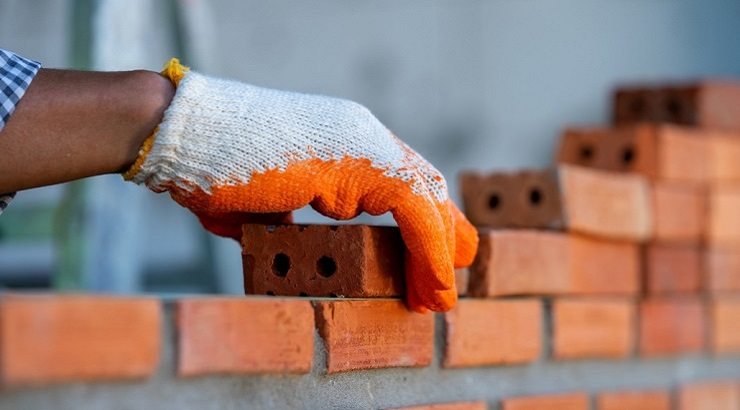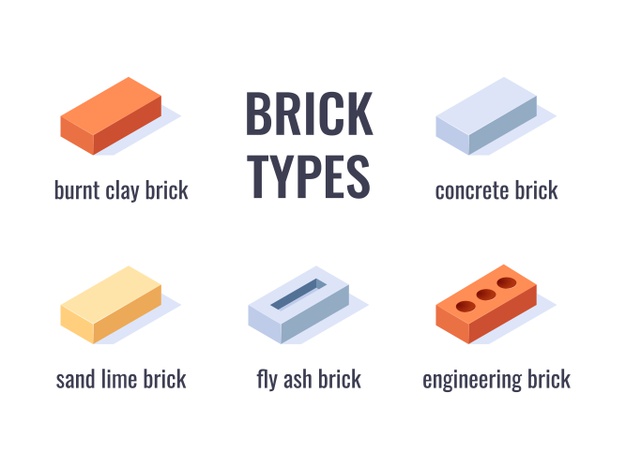Materials & Supplies
Types of Bricks Used in Construction
Overview of the different types of bricks used in construction.

Brick is a building product bonded with cement mortar during construction.
The product, which is available in clay, shale, sand, lime, and concrete, is widely used in construction due to its versatility and strength.
Different types of bricks available in the construction field are explained here.
1. Sun-dried clay bricks
These are ancient-type sun-dried clay or mud bricks. They are made using sun-baked moulds of mud. These bricks are then stacked and bonded with additional mud. They are not durable for construction and are only used in adobe-style homes.
2. Burnt clay bricks
These are made by moulding wet clay into bricks and then burning them in a kiln. Available in classes 1 to 3, class 1 being the best quality, the usage of these bricks ranges from structural masonry walls to foundation and masonry columns.
3. Sand lime bricks
Sand-lime bricks, or calcium silicate bricks, are made of fly ash, sand, lime, and optional pigments, and are pressure-moulded and chemically vitrified
They are fit for structural foundations, load-bearing applications, and exposed brickwork. When well-engineered, they can be used for decorative purposes.
4. Engineering bricks
Engineered bricks are designed for civil projects that require durability and weather resistance. Very high in the burning zone, these bricks, cured with extreme temperature, exhibit high compressive strength with very low porosity.
Available in classes A and B, they are suitable for civil projects requiring high compressive strength and low water absorption.
5. Concrete bricks
Concrete bricks are made by pouring concrete into a mould. Traditionally used as interior bricks, they are now also utilized for aesthetic purposes indoors. Hard and colourful, concrete bricks are very viable in any type of building.
6. Fly ash clay bricks
Fly ash clay bricks are made by subjecting clay and fly ash to high temperatures. They have improved fire resistance and are lighter. The calcium oxide in these bricks ensures self-cementation.
These bricks are commonly used for large walls, foundations, and thermal insulation, ostensibly reducing the consumption of energy.
RELATED: Types of Bricks Bonds Used in Masonry
Although not as dense as clay or concrete bricks, fly ash clay bricks should be handled with care since they have a slight expansion when wet.
7. Fire bricks
Fire bricks, or refractory bricks, are made by using silica and high aluminium oxide. This enables the bricks to withstand high temperatures, which makes them convenient for use in furnaces, kilns, ovens, or chimneys.

Benefits of bricks
There are many advantages offered by bricks as a building material:
• Aesthetic appeal: Bricks are available in a variety of colours and textures, thus augmenting the appearance of a particular project.
• Thermal insulation: Bricks moderate the temperature owing to their high heat capacity, thereby preserving the thermal efficiency of a building.
• Durability: Bricks are highly compressible and resistant to severe wearing and tearing for a long time, which makes a building more durable.
• Sustainability: Bricks are a sustainable building material.
• Fire protection: Bricks provide excellent facilities regarding the protection of fire hazards, saving structures as well as lives.
• Noise reduction: Bricks reduce noise, ensuring quiet interior spaces.
RELATED: Standard Brick Dimensions
Types of bricks
Bricks are categorised by facing, method of production, and use, which offers builders a variety of options for their projects.
• Facing vs. backing bricks
• Unfired vs. fired bricks
• Common vs. engineering bricks
In addition, bricks are available in many forms, such as veneers, air bricks, perforated bricks, bullnose bricks, paving bricks, and hollow bricks, which are suitable for a range of construction requirements.














